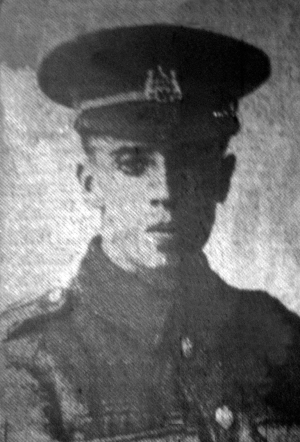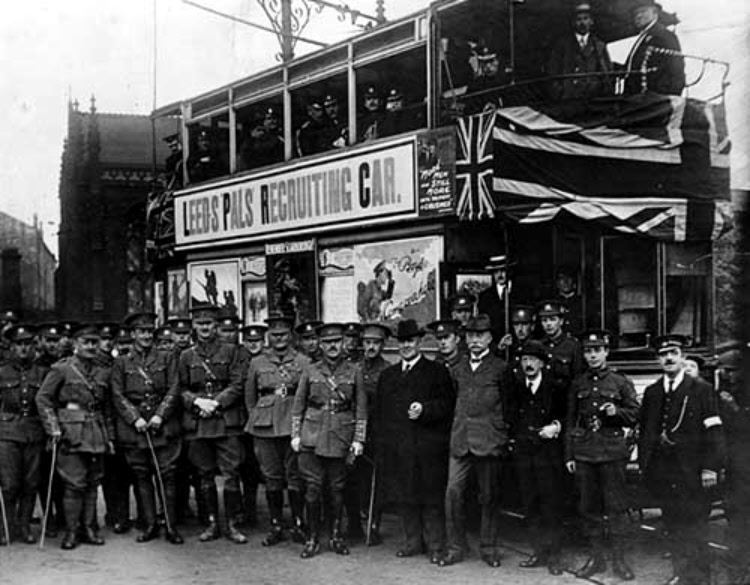 Private Israel Burnett Westerman, 15/1277, West Yorkshire Regiment (Prince of Wales's Own), 15th Battalion ("Leeds Pals")
Private Israel Burnett Westerman, 15/1277, West Yorkshire Regiment (Prince of Wales's Own), 15th Battalion ("Leeds Pals")
Israel Burnett Westerman was born in Hirst, Northumberland in 1895, the son of Lincoln Westerman (b. 1866, Whitkirk, Leeds) and his wife Sarah Elizabeth (nee Chrisp, b. 1873, Alnwick) who had married in 1894 in the Morpeth registration district. Israel was the eldest of two children born to the couple; the younger son being William Westerman, born in 1899, also in Hirst, Northumberland.
By 1901, Israel and his younger brother, William are living with their parents at 16 Cliff Terrace, Micklefield, near Leeds and their father Lincoln Westerman is working as a hewer in a coal mine.
Lincoln Westerman and his family moved to Ossett before 1911, where he was a Wesleyan town missioner or lay preacher and the Westerman family lived at 36, Rycroft Street, Ossett. Israel was working as a draper's assistant in 1911. Lincoln Westerman died in Ossett, at the age of 71, in 1937.
The 15th (Service) Battalion (1st Leeds), West Yorkshire Regiment was formed in Leeds in September 1914 by the Lord Mayor and City and in June 1915 came under the orders of 93rd Brigade, 31st Division. After initial training at Skipton and Ripon (North Yorkshire), the Regiment was sent to Egypt on the 6th December 1915 to take part in the Defence of Suez. They first arrived at Alexandria, but later sailed to Port Said and finally to Kantara, which was on the east bank of the Suez Canal. They were encamped in an area known as 'Point 70'.
The Regiment stayed in Egypt from 21st December 1915 until the 1st March 1916, finally arriving in Marseilles France on the 6th March 1916. From Marseilles they entrained for the journey to Pont Remy, finally marching to Mereleaasart. On the 7th December 1917, the (1st Leeds) 15th Battalion amalgamated with (2nd Leeds) 17th Battalion to form 15th/17th Battalion after both "Pals" battalions suffered heavy losses.
Israel B. Westerman's service number 15/1277 suggests that he was one of the original "Leeds Pals" and he enlisted at Colsterdale, Yorkshire in early 1915, serving as a Private with '10' Platoon of 'C' company. His army service record has not survived, but his MIC records that in addition to the British and Victory medals, he was also awarded the 1914-15 Star.
It was to be Lord Kitchener's "Call to Arms" that would help bring together many new army regiments, such as the 1st Leeds, 15th (Service) Battalion, Prince of Wales's Own (West Yorkshire Regiment), more famously known as the "Leeds Pals". The general idea of a Pals battalions was that the volunteers would join and serve with friends, relatives, workmates and colleagues, giving a feeling of comradeship that had never been seen before. Most major towns and cities along with Leeds raised pals battalions.
However, to be accepted to these elite units the recruits were to pass certain requirements. Education and intelligence were considered paramount to being accepted in the majority of cases. It was not only businessmen, and local dignitaries however, that were recruited and by the 8th of September 1914, the battalion had enlisted some 1,275 men after rejecting many on medical grounds. This number at the time was considered to be complete although the final number of "Leeds Pals" eventually rose to approximately 2,000. It would appear that each man chosen to be a pal had something to offer be it previous military experience, leadership qualities, or physical prowess. A certain high standard had been set, and each individual reached this, although the average age was 20-21 years old.
Training was to be rigorous and took place at Colsterdale on the Yorkshire Dales. Between September 1914 and May 1915. Colonel J. Walter Stead was the commanding officer of the battalion and he was later replaced by Lieutenant-Colonel Stuart Campbell Taylor. France was expected to be the Pals first destination, but this was not so. Early December 1915 saw the first group of Pals set sail for Suez. Inevitably, France was to be for many of the Pals their final destination. On March 1st 1916 the Pals set sail for Marseilles as the Battle of the Somme became imminent. The battle was to prove tragic for the "Leeds Pals". On that fateful day, 1st July 1916, approximately 750 out of 900 "Leeds Pals" involved in the Battle of the Somme died.
In a relatively small-scale Somme offensive, on the Thursday, 3rd of May 1917, at Oppy Wood, near the French village of Gavrelle, this date would also become synonymous with the 1st of July 1916, as once again many Pals battalions were thrown into the fray, with heavy casualties being inflicted on the recently rebuilt groups of men. Early on the morning of the 3rd of May the 15th Battalion of the West Yorkshire Regiment. the "Leeds Pals", launched an attack on Windmill trench. Of the 547 men who started the attack, some 157 were fatalities, cut down by machine guns, 120 were missing and 120 were wounded, nearly half the total battalion strength being taken out in a single day. Many of the bodies of those killed were never recovered, including Private Israel B. Westerman.
The "Ossett Observer" 1 reported the death of Israel Westerman after he was at first posted missing with two other Ossett soldiers, Harold Brown and John Ellis, who had all joined the "Leeds Pals" and were all killed in action during the same battle at Oppy Wood, near Gavrelle:
"Official intimation has been received this week by Mr. L. Westerman, Wesyleyan town missioner, of Ryecroft-street, Ossett, that his son, Private I.B. Westerman, of the West Yorkshire Regiment 'Leeds Pals', who was reported missing on May 3rd, 1917, was killed in action that day or a subsequent date.
The war had only been in progress a few months when Private Westerman voluntarily joined the forces, and in December 1915, he proceeded to the near East. After the evacuation of Gallipoli he went to France, where he experienced a good deal of fighting, and was wounded on more than one occasion. Once the machine-gun which he was operating was struck by a shell and broken to splinters, and he was buried in the debris, sustaining severe internal injuries. Though his life was despaired of at the time, he made a remarkable recovery. Returning to the Western front, he took part in an attack on Gavrelle in May last year and was never heard of afterwards. He was 22 years of age and used to be employed by Mr. Hallas, draper, of Bank-street, Ossett and afterwards worked at Leeds and Hammersmith. His brother, William is serving in France."
Private Israel Burnett Westerman (24), son of Mr. and Mrs. Lincoln Westerman, of 36, Ryecroft Street, Ossett, Yorks was killed in action on the 3rd of May 1917 in fighting around Oppy Wood near Gavrelle, France.
On the 1st of July 1916 on the first day of the battle of the Somme, 'C' company of the Leeds Pals were the first over the top. Israel was wounded within the first few minutes and later evacuated to a first aid post behind the lines, after several weeks in hospital he retuned to his unit, then in late 1916 he was again wounded, although this time it was not serious enough to require hospital treatment.
Israel’s younger brother William, also served as a Private with the West Yorkshire Regiment, and although severely wounded in late 1917, he survived the war.

Above: The "Leeds Pals" recruiting tram that was used in 1914 to encourage local men to volunteer.
Private Israel Burnett Westerman is remembered on Bay 4 of the Arras Memorial 2, Pas de Calais, France. The Arras Memorial is in the Faubourg-d'Amiens Cemetery, which is in the Boulevard du General de Gaulle in the western part of the town of Arras.
The French handed over Arras to Commonwealth forces in the spring of 1916 and the system of tunnels upon which the town is built were used and developed in preparation for the major offensive planned for April 1917.
The adjacent Arras Memorial commemorates almost 35,000 servicemen from the United Kingdom, South Africa and New Zealand who died in the Arras sector between the spring of 1916 and 7 August 1918, the eve of the Advance to Victory, and have no known grave. The most conspicuous events of this period were the Arras offensive of April-May 1917, and the German attack in the spring of 1918. Canadian and Australian servicemen killed in these operations are commemorated by memorials at Vimy and Villers-Bretonneux. A separate memorial remembers those killed in the Battle of Cambrai in 1917.
References:
1. "Ossett Observer", 27th April 1918